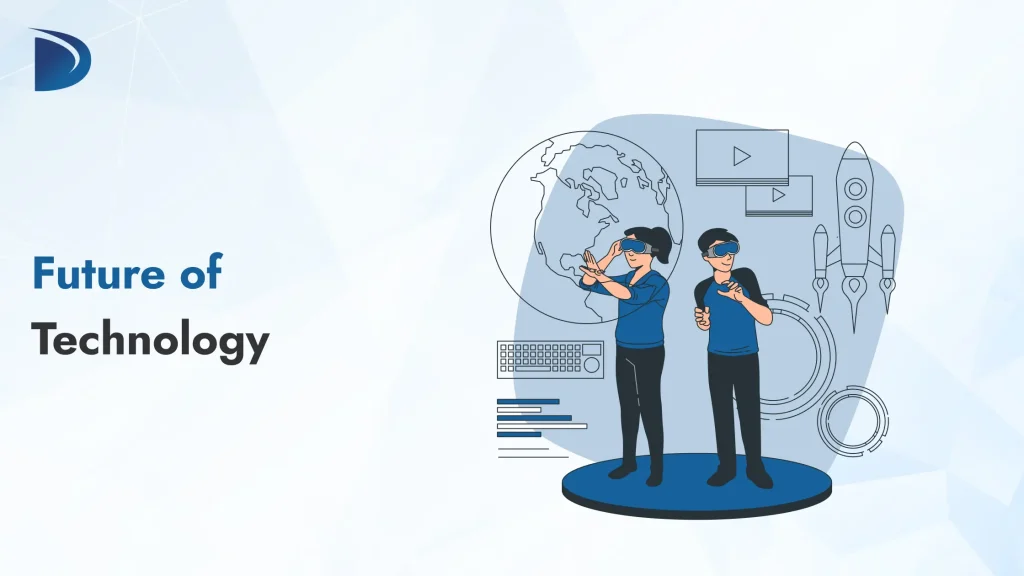Table of Contents
The future of technology promises to transform how we live, work, and interact with the world. From artificial intelligence to quantum computing, emerging innovations are set to redefine industries, enhance human capabilities, and address global challenges. This article explores the key trends shaping the future of technology, their potential impact, and the opportunities and challenges they bring.
What Does the Future of Technology Hold?
The future of technology is about leveraging cutting-edge advancements to solve problems, improve efficiency, and create new possibilities. Rapid developments in AI, biotechnology, renewable energy, and connectivity are driving a new era of innovation. These technologies reshape industries and redefine societal norms, economies, and human experiences.
Key Trends Shaping the Future of Technology
Here are the most transformative technologies expected to dominate the coming decades:
1. Artificial Intelligence and Machine Learning
- What It Is: AI and ML enable machines to learn, reason, and make decisions, mimicking human intelligence.
- Future Impact:
- Personalization: Hyper-tailored experiences in healthcare, education, and entertainment.
- Automation: Streamlining industries like manufacturing, logistics, and customer service.
- Ethics and Governance: Focus on transparent, bias-free AI systems.
- Example: AI-driven diagnostics predicting diseases with 95% accuracy (Google Health, 2024).
- Stat: The global AI market is projected to reach $1.8 trillion by 2030 (Statista).
2. Quantum Computing
- What It Is: Quantum computers use quantum mechanics to process data exponentially faster than classical computers.
- Future Impact:
- Solving complex problems in cryptography, drug discovery, and climate modeling.
- Revolutionizing cybersecurity with unbreakable encryption.
- Example: IBM’s quantum computers are tackling optimization problems for supply chains.
- Stat: Quantum computing investment is expected to hit $9 billion by 2027 (McKinsey).
3. 5G and Next-Generation Connectivity
- What It Is: Advanced networks like 5G and 6G offer ultra-fast speeds, low latency, and massive device connectivity.
- Future Impact:
- Enabling smart cities with real-time traffic and energy management.
- Powering IoT ecosystems for connected homes, cars, and wearables.
- Example: 5G-powered autonomous vehicles communicating in milliseconds.
- Stat: 5G connections are projected to reach 5.5 billion by 2027 (Ericsson).
4. Biotechnology and Health Tech
- What It Is: Innovations in gene editing, personalized medicine, and wearable health devices.
- Future Impact:
- Curing genetic diseases using CRISPR and other gene-editing tools.
- Real-time health monitoring via AI-powered wearables.
- Extending human lifespan through regenerative medicine.
- Example: Wearables detecting early signs of heart disease with 90% accuracy.
- Stat: The biotech market is expected to grow to $3.4 trillion by 2030 (Grand View Research).
5. Green and Sustainable Technology
- What It Is: Technologies like renewable energy, carbon capture, and sustainable materials to combat climate change.
- Future Impact:
- Achieving net-zero emissions through solar, wind, and hydrogen energy.
- Reducing waste with biodegradable materials and circular manufacturing.
- Example: AI optimizing energy grids to cut consumption by 20%.
- Stat: Renewable energy will account for 50% of global power by 2050 (IEA).
6. Augmented Reality (AR) and Virtual Reality (VR)
- What It Is: Immersive technologies blend digital and physical worlds or create virtual environments.
- Future Impact:
- Transforming education with interactive, virtual classrooms.
- Enhancing remote work with AR collaboration tools.
- Redefining entertainment with metaverse ecosystems.
- Example: AR glasses overlaying real-time data for surgeons during operations.
- Stat: The AR/VR market is expected to reach $300 billion by 2028 (Fortune Business Insights).
7. Robotics and Automation
- What It Is: Advanced robots and automation systems for industrial, domestic, and service applications.
- Future Impact:
- Automating repetitive tasks in warehouses, agriculture, and healthcare.
- Companion robots assisting the elderly or disabled.
- Example: Drones delivering medical supplies in remote areas.
- Stat: The global robotics market is projected to hit $87 billion by 2025 (IDC).
Benefits of the Future of Technology
- Efficiency and Productivity: Automation and AI streamline workflows, saving time and resources and ensuring a more productive future.
- Global Connectivity: Faster networks and immersive tech bridge distances for collaboration.
- Sustainability: Green tech reduces environmental impact and promotes a circular economy.
- Improved Quality of Life: Health tech and personalized services enhance well-being.
- Innovation Acceleration: Quantum computing and biotech unlock solutions to previously unsolvable problems.
Challenges to Address
The future of technology also presents significant challenges:
- Ethical Concerns: AI and biotech raise questions about privacy, consent, and bias.
- Job Disruption: Automation may displace workers, requiring reskilling programs.
- Digital Divide: Unequal access to technology could widen socioeconomic gaps.
- Security Risks: Advanced tech like quantum computing could threaten current encryption methods.
- Environmental Impact: Manufacturing tech components must balance sustainability with demand.
How to Prepare for the Future of Technology
To thrive in a tech-driven world, individuals and businesses should:
- Stay Informed: Keep up with trends through reliable sources like industry reports or platforms like X.
- Upskill Continuously: Learn AI, coding, or data analysis skills to stay relevant.
- Adopt Early: Experiment with emerging tools to gain a competitive edge.
- Prioritize Ethics: Support transparent and inclusive tech development.
- Invest in Sustainability: Choose technologies that align with environmental goals.
The Role of Society in Shaping Technology’s Future
The future of technology depends on how society adopts and governs it. Collaboration between governments, businesses, and communities is crucial to ensure:
- Inclusive Access: Bridging the digital divide to make tech available to all.
- Responsible Innovation: It’s crucial to develop AI and biotech by strictly adhering to ethical guidelines and ensuring these technologies serve humanity’s best interests.
- Sustainable Practices: It’s imperative to prioritize the development and use of eco-friendly tech to combat climate change, ensuring a sustainable future for all.
By 2030, technology is projected to significantly contribute $15.7 trillion to the global economy (PwC), underscoring its transformative potential.
Conclusion
The future of technology is bright, with innovations like AI, quantum computing, and green tech poised to reshape our world. These advancements promise greater efficiency, connectivity, and sustainability while addressing global challenges like climate change and healthcare. However, ethical governance, equitable access, and workforce readiness are essential to maximize benefits and minimize risks. We can build a more thoughtful, inclusive, and sustainable tomorrow by responsibly embracing technology’s future.

